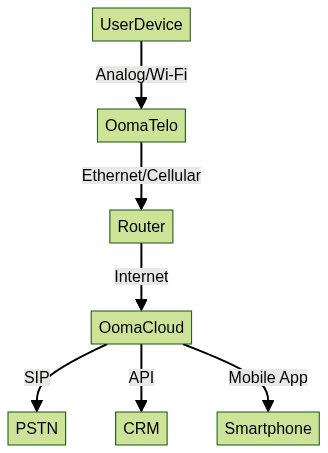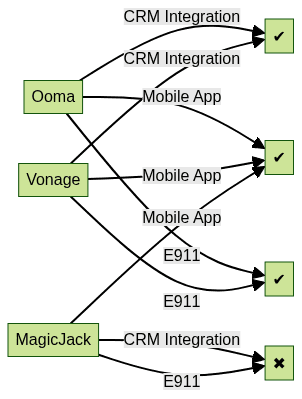The Ultimate Guide to the Ooma Phone System (2025)
Introduction to Ooma Phone System
In the rapidly evolving world of digital communications, the Ooma phone system stands out as a robust solution for both home and business users. Known for its reliability, cost-effectiveness, and advanced VoIP capabilities, Ooma transforms traditional telephony into a modern, cloud-based communication platform. Whether you are a developer seeking to integrate telephony into your stack, an IT professional managing business communications, or a homeowner looking to cut the cord from traditional landlines, the Ooma phone system offers tailored solutions to fit your needs. This guide explores Ooma's technology, features, setup, pricing, and security aspects, with a focus on technical insights relevant for 2025.
What is the Ooma Phone System?
The Ooma phone system is a Voice over Internet Protocol (VoIP) service that replaces traditional landline telephony with internet-based communications. Leveraging cloud infrastructure, Ooma enables users to make and receive calls using dedicated hardware (like the Ooma Telo or Ooma Office base station) or through mobile and desktop applications. For residential users, Ooma provides a seamless transition from POTS (Plain Old Telephone Service) to digital, while for businesses, it delivers scalable PBX features without the complexity or cost of legacy systems. The Ooma phone system ensures high-quality voice transmission, advanced call management, and integration options suitable for modern software environments. For those interested in building custom telephony solutions, exploring a
phone call api
can offer additional flexibility and integration possibilities.Key Features of the Ooma Phone System
Home Solutions
Ooma's residential offerings include the Ooma Telo, Ooma Telo Air (Wi-Fi enabled), and Ooma Telo LTE (cellular backup). These devices deliver free nationwide calling, robust call blocking, enhanced 911 (E911), and integration with smart home platforms. Setup is plug-and-play, making it easy for developers and tech-savvy users to deploy advanced telephony in minutes. The Ooma phone system for home is an ideal POTS replacement, offering mobile app support for on-the-go calling and voicemail management. If you're developing cross-platform communication apps, you might also consider leveraging
webrtc android
orflutter webrtc
for real-time audio and video capabilities.Business Solutions
For businesses, Ooma Office provides a comprehensive suite of features: virtual receptionist, multi-extension support, ring groups, and CRM integrations. Plans like Essentials, Pro, and Pro Plus cater to different organization sizes and needs. Ooma Office supports desk phones, softphones, and mobile devices, enabling remote and hybrid teams to stay connected. Developers benefit from APIs and integration points for workflow automation, while IT admins appreciate centralized management and enterprise-grade security. Businesses looking to add video conferencing can enhance their communication stack with a
Video Calling API
orembed video calling sdk
for seamless collaboration.Advanced Features
Ooma's advanced features include:
- Cross-platform mobile apps (iOS, Android)
- International calling at competitive rates
- Enhanced 911 with location tracking
- Automated call routing and voicemail transcription
For developers aiming to build robust voice applications, integrating a
Voice SDK
can facilitate advanced audio features and live audio rooms. Additionally, those working on iOS can benefit from acallkit tutorial
to implement native call interfaces in their VoIP apps.Example VoIP setup configuration (SIP registration):
ini
[Ooma-Account]
host = sip.ooma.com
username = <your_ooma_username>
secret = <your_api_token>
type = peer
qualify = yes
nat = yes
context = from-oomaOoma Phone System Setup and Installation
Residential Setup
Setting up the Ooma phone system for home is straightforward. Simply connect the Ooma Telo device to your router via Ethernet or Wi-Fi (Ooma Telo Air), and plug in your existing analog phone. For Ooma Telo LTE, cellular backup ensures calls even during internet outages. The intuitive web interface allows configuration of call forwarding, blocking, and voicemail.
Business Setup
Deploying Ooma Office in a business environment involves connecting desk phones to the Ooma base station (via Ethernet), setting up user accounts, and configuring extensions through the admin portal. The Ooma mobile app lets teams work from anywhere, while the virtual receptionist can be programmed to route calls based on schedules or caller input.
Troubleshooting Common Issues
Common Ooma issues include call quality drops, registration failures, or device connectivity. Most problems are resolved by checking network QoS settings, updating firmware, or rebooting devices. Ooma offers responsive customer support and detailed diagnostics in the admin portal. For businesses seeking more integration options, a
phone call api
can help automate call workflows and improve troubleshooting.
Ooma Phone System Pricing and Plans
Home Plans (Basic vs Premier)
Ooma Basic offers free U.S. calling, voicemail, and basic features with minimal monthly fees (just taxes/fees). Ooma Premier adds advanced call blocking, voicemail-to-email, and integration with smart home devices for a monthly subscription.
Business Plans (Essentials, Pro, Pro Plus)
Ooma Office Essentials includes unlimited calling, virtual receptionist, and a mobile app. Pro adds call recording, voicemail transcription, and enhanced reporting. Pro Plus extends to CRM integration, advanced analytics, and expanded international calling.
Additional Costs & Fees
Expect one-time hardware costs for Telo or Office base stations, as well as optional accessories like wireless adapters or expansion handsets. Porting your existing number is typically free, and international rates are competitive.
Comparing Ooma with Other Phone Systems
Ooma vs Traditional Landlines
The Ooma phone system offers significant savings over POTS, as there are no legacy infrastructure maintenance costs and monthly charges are lower. Reliability is enhanced with cloud redundancy and cellular backup options. Feature-wise, Ooma eclipses landlines by offering call blocking, mobile access, and smart integrations that legacy phone systems lack.
Ooma vs Other VoIP Providers
Compared to Vonage and MagicJack, Ooma stands out for its easy setup, superior voice quality, and robust feature set. Ooma Office provides a more comprehensive business suite than MagicJack, and more competitive pricing for small teams than Vonage. Developers appreciate Ooma's open integration approach and detailed admin controls.

Security and Reliability of the Ooma Phone System
Ooma prioritizes security with end-to-end call encryption, secure device provisioning, and enhanced 911 services. Cloud-based redundancy and LTE backup options ensure business continuity even in network outages. The Ooma phone system is trusted by developers and IT teams for its compliance with modern security standards and its robust failover strategies for emergency scenarios.
Customer Reviews and Use Cases
Ooma consistently receives high ratings for call clarity, ease of use, and customer support. Home users appreciate the spam call blocking and cost savings, while small businesses praise the scalable, feature-rich platform. Example use cases include:
- A remote tech company integrating Ooma Office with their CRM for streamlined client communications
- A home user replacing POTS with Ooma Telo for reliable, low-cost nationwide calling
How to Get Started with Ooma Phone System
Getting started is simple: purchase the Ooma device (Telo for home, Office for business), follow the guided online setup, and create your account. Port your existing number via the web portal, configure user preferences, and deploy to users or family. The Ooma phone system is operational within minutes. If you're ready to experience modern communication,
Try it for free
and see how Ooma can transform your home or business telephony.Conclusion: Is Ooma Phone System Right for You?
The Ooma phone system is ideal for tech-savvy homeowners, remote workers, and small-to-medium businesses seeking a modern, cost-effective telephony solution. Pros include easy setup, strong security, and broad feature coverage. Cons may include initial hardware cost and dependency on stable internet. If you value flexibility, scalability, and cloud integrations, Ooma is a leading choice in 2025.
External Links and Further Reading
Want to level-up your learning? Subscribe now
Subscribe to our newsletter for more tech based insights
FAQ